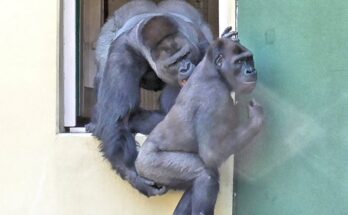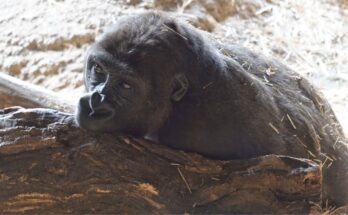1 Two Main Species, Several Subspecies
Gorillas are divided into two main species: Eastern gorillas and Western gorillas, with subspecies like the mountain gorilla and the western lowland gorilla. Each has unique characteristics and habitats.
2 They Live in Tight-Knit Families
Gorillas live in groups called “troops” or “bands,” led by a dominant silverback male. A troop often includes multiple females and their young, and sometimes younger males. Groups can range from 5 to over 30 individuals.
3 The Largest Great Apes
Gorillas are the biggest primates in the world. Adult males can weigh over 200 kg (about 440 lbs) and reach up to 1.8 meters (6 feet) when standing upright.
4 The Mighty Silverbacks
The term “silverback” comes from the patch of silver hair on a mature male’s back. These leaders are responsible for protecting and guiding the group. They’re powerful, wise, and deeply caring toward their troop.
5 They’re Mostly Vegetarian
Gorillas eat large amounts of vegetation—up to 30 kg (66 lbs) of leaves, shoots, fruits, and stems per day. Occasionally, they may eat insects or small invertebrates.
6 They Build Beds Every Night
Every evening, gorillas make nests from leaves and branches—either on the ground or in trees—to sleep in. They rarely use the same nest twice.
7 Highly Intelligent Creatures
Gorillas have been observed using tools, like sticks to test water depth or to gather food. In captivity, some have learned basic sign language and can recognize themselves in mirrors.
8 They Communicate in Many Ways
Gorillas use over 25 vocalizations to communicate. These include grunts, hoots, roars, and chest-beating. Each sound has different meanings, from warnings to reassurances.
9 They’re Closely Related to Humans
Gorillas share 96%–99% of their DNA with us. They are one of our closest relatives in the animal kingdom, only behind chimpanzees and bonobos.
10 They’re Endangered, But There’s Hope
Most gorilla subspecies are critically endangered due to habitat loss, poaching, and disease. However, conservation efforts have helped mountain gorilla numbers rise to over 1,000 today—a hopeful sign for the future.
🕒 Extra Facts
- Reproduction: Females give birth about every 4–6 years after an 8–9 month pregnancy.
- Lifespan: Wild gorillas live 35–40 years; some in zoos have lived past 60.
- Ecosystem Role: Gorillas help forests thrive by dispersing seeds and opening gaps in the forest canopy, allowing new plants to grow.
🌱 Why They Matter
Gorillas are gentle giants with complex emotions, strong social bonds, and impressive intelligence. Protecting them means protecting entire forest ecosystems that benefit countless other species—including humans.


